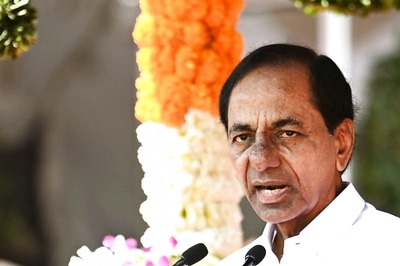
views
New Delhi: When actor Mithun Chakraborty burst into the silver screen in the late 70s and early 80s with the swagger of a matinee idol that belied a baby face and amazingly intense eyes, it triggered mini tremors in an industry traditionally suspicious of outsiders.
The white poncho is gone, the white pants are a really tight fit these days and budget cuts have pruned the power supply to psychedelic stage lights, but as Jimmy the street dancer turns 61 on Thursday, he has every right to look back with pride at a career built on blood, sweat and dreams.
Disco Dancer, now an urban legend, has been spoofed in a preppy track in the upcoming Imran Khan starrer 'Delhi Belly.' But the star behind the legend is still as much a crusader and a common man as he was when he started out as a penniless actor sleeping on benches in Mumbai.
The hungry street fighter
When Mithun (Gouranga) Chakraborty came looking for work in Mumbai, he had two factors working against him; the inability to speak Hindi devoid of a gravelly and heavy Bengali accent and the dark, chiseled looks of a hungry street fighter.
Both were unfit for an age when Bollywood was dominated by swarthy heroes playing syrupy-romantic leads opposite swooning damsels in mega-budget dream flicks. Mithun’s success story is based on how he turned around the two negatives into a staggering positive and changed the trend in ‘80s mainstream cinema.
In one of his early interviews Mithun said he survived in Mumbai on "fresh air, water, humiliation and the rejection of all filmmakers". Producers were reluctant to take the risk of launching a young actor meticulously trained in martial arts, structured dance and finer points of acting – attributes missing in many of the popular leads at the time.
A breakthrough and India’s first disco movie
The actor’s National Award winning debut in the arthouse classic ‘Mrigaya’ (1976) directed by Mrinal Sen was not enough to attract mainstream filmmakers. He went on to do character roles in 'Do Anjaane' (1976) and 'Phool Khile Hain Gulshan Gulshan' (1977).
The much-needed break came in the form of India's first mega hit on the disco genre. Overnight street dancer Jimmy won over an elitist audience with an electric guitar and pelvic thrusts that were to become iconic in the years to come in the 1982 cult film 'Disco Dancer'.
'Kasam Paida Karne Wale Ki' (1984), 'Dance Dance' (1987) soon followed and established Mithun as a dancing star. Mithun's years of copying Michael Jackson's moves finally culminated in a fan following amongst the ‘80s youths who copied everything from the lithe moves and the upturned collar to the blown out hair and mannerisms.
Mithun, the action star
So he dances well, big deal, critics said at a time when a series of hit films ensured that Mithun had arrived on the scene. He was yet to decide his specialization. Films such as 'Mujhe Insaaf Chahiye' (1983), 'Ghar Ek Mandir' (1984), 'Pyaar Jhukta Nahin' (1985) and 'Pyaar Ka Mandir' (1988) got mixed response at the box office and among critics.
The '70s was a decade also of action heroes and Amitabh Bachchan was a name to recon with, with his larger-than-life on screen persona. Mithun was facing stiff competition.
But Mithun's 'Jagir' (1984), ‘Watan Ke Rakhwale’ (1987), ‘Waqt ki Awaz’ (1988) propelled him to stardom as an action hero. This was a heady time for Mithun who paired against some of the best known actresses in Bollywood - Zeenat Aman, Rekha, Sridevi, Madhuri Dixit, Ranjeeta, Yogeeta Bali, Rati Agnihotri, Tina Munim and Padmini Kolhapuri.
He was careful to balance his career with remarkably sensitive acting in films such as ‘Tahader Katha’, ‘Swami Vivekananda’, ‘Kalpurush’, ‘Agneepath’, ‘Jallad’ and ‘Titli’.
The business formula
But the ‘90s saw his popularity slipping with the rise of fresh faced teen stars and star sons that fit into fluffy romantic roles better than Mithun ever could. Mithun shifted his industry to the hilly haven of Ooty and launched a business that is still a voluble, working model amongst B-grade filmmakers looking to churn out low investment, moderate return quickies.
A string of B-grade films followed that saw him in various roles, sometime churning out as many as eight films in a year and delivering as many as 30 flops in the course of five years. In a high-budget industry where smaller films are known to struggle for survival, Mithun’s model was simple and successful at a time most producers reported massive losses.
Small budget producers were required to shoot in the locales of Ooty where he owned and operated a hotel business, committed to bulk dates and often starred opposite aspiring southern and Bhojpuri stars. Hit movies such as ‘Dalaal’ (1993) and ‘Phool Aur Angaar’ (1994) are products of this model.
The ‘dada’ of TV
But Mithun is still far from his swansong. Affectionately referred to as ‘Dada’, Mithun is noted for as much for his charity work, as for his television debut in popular dance reality shows.
Having appeared in more than 250 films in a career spanning over three decades the dancing star remains close to the heart of millions of youngsters fighting for a dream.



















Comments
0 comment